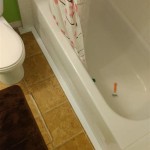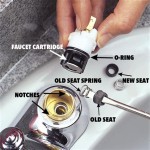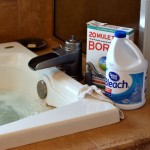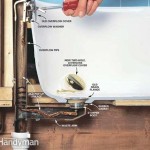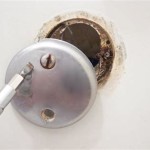Can You Spray Paint A Bathtub White? A Comprehensive Guide
The question of whether a bathtub can be spray painted white commonly arises when considering budget-friendly bathroom renovations. While seemingly a simple solution to update an old or stained tub, the process involves several critical factors that determine the success and longevity of the finish. This article will explore the feasibility of spray painting a bathtub white, outlining the necessary steps, challenges, and considerations for achieving a durable and aesthetically pleasing result.
Many homeowners are drawn to the idea of spray painting as it appears to be a straightforward and relatively inexpensive alternative to replacing a bathtub. Replacing a bathtub involves significant demolition, plumbing work, and associated installation costs. Spray painting, on the other hand, seems to offer a quick fix to improve the appearance. However, the reality is that properly preparing the surface and selecting the correct materials are crucial for achieving a professional-looking and long-lasting finish.
The existing condition of the bathtub plays a significant role in determining the suitability of spray painting. A bathtub with minor cosmetic imperfections, such as small scratches or stains, is a more suitable candidate for refinishing than one with significant structural damage, deep rust, or extensive chipping. In cases of severe damage, replacement is often the more practical and cost-effective option in the long run.
Surface Preparation is Paramount
The success of any paint job, including spray painting a bathtub, hinges on the preparation of the surface. Inadequate surface preparation is the most common reason for paint failure, resulting in peeling, chipping, and an overall unsatisfactory outcome. The preparation process is meticulous and requires several key steps to ensure proper adhesion of the new finish.
The first step involves thoroughly cleaning the bathtub to remove all traces of soap scum, mildew, and other contaminants. Abrasive cleaners such as powdered cleansers or specially formulated bathtub cleaners are effective for this purpose. It is essential to rinse the surface thoroughly to remove any residual cleaning agents, as these can interfere with the adhesion of the primer and paint.
After cleaning, the bathtub should be inspected for any existing damage, such as chips, cracks, or rust. These imperfections must be addressed before applying any primer or paint. Small chips and cracks can be filled with epoxy-based fillers specifically designed for bathroom surfaces. These fillers provide a smooth and durable base for the new finish. Rust must be completely removed using a wire brush or rust remover. Any remaining rust can bleed through the new paint layer, causing discoloration and further damage.
Once the repairs are complete, the entire bathtub surface must be roughened using sandpaper. This step is critical for creating a mechanical bond between the existing surface and the new primer and paint. Sandpaper with a grit of between 220 and 320 is typically recommended. The goal is not to remove the existing finish entirely but to create a slightly textured surface that the new materials can adhere to. After sanding, the surface should be thoroughly cleaned again to remove any sanding dust.
Finally, masking is an essential part of the preparation process. All surrounding areas, including the walls, fixtures, and drain, should be carefully masked off to protect them from overspray. High-quality painter's tape and plastic sheeting are recommended for this purpose. Proper masking ensures a clean and professional-looking finish.
Choosing the Right Materials
Selecting the appropriate materials is just as important as the surface preparation. The type of primer and paint used will directly impact the durability, appearance, and longevity of the finish. Not all paints are created equal, and using the wrong type of paint can lead to premature failure and a waste of time and resources.
A high-quality epoxy primer is essential for creating a strong bond between the existing surface and the new paint. Epoxy primers are known for their excellent adhesion, durability, and resistance to water and chemicals. They are specifically formulated to adhere to hard, non-porous surfaces such as porcelain and ceramic, which are commonly used in bathtubs. The primer should be applied in thin, even coats, following the manufacturer's instructions. Allow the primer to dry completely before proceeding to the next step.
For the topcoat, specialized epoxy acrylic paints designed for bathtub refinishing are recommended. These paints offer a combination of durability, chemical resistance, and aesthetic appeal. They are formulated to withstand the harsh conditions of a bathroom environment, including exposure to water, soap, and cleaning agents. Automotive paints are also sometimes used due to their durability and ability to create a smooth, glossy finish. However, it is crucial to ensure that the chosen paint is compatible with the primer used.
When choosing the paint color, white is a popular option due to its clean and classic look. However, it is important to select a white paint that is specifically designed for bathroom use. Some white paints can yellow over time due to exposure to moisture and UV light. Look for paints that are formulated to resist yellowing and maintain their color integrity.
The application method also plays a role in the final result. While spray painting is a common technique, it requires specialized equipment and experience to achieve a smooth, even finish. Aerosol spray cans can be used for small touch-ups, but for larger areas, a professional-grade spray gun is recommended. This allows for better control over the paint flow and ensures a more uniform application.
Challenges and Considerations
Spray painting a bathtub white is not without its challenges. Several factors can impact the success of the project, and it is important to be aware of these challenges before embarking on the process.
One of the biggest challenges is achieving a smooth, even finish. Spray painting requires a steady hand and consistent technique to avoid runs, drips, and other imperfections. Uneven application can result in a blotchy or textured finish that is not aesthetically pleasing. Practice on a scrap surface before applying the paint to the bathtub is highly recommended. Additionally, maintaining proper ventilation is crucial when working with spray paint. Fumes can be harmful, and adequate ventilation is necessary to protect your health.
Durability is another key consideration. While a properly prepared and painted bathtub can look great initially, the finish may not be as durable as the original factory finish. The new finish is susceptible to chipping, scratching, and peeling, especially in high-use areas. Regular cleaning and maintenance are essential to prolong the life of the finish. Avoid using abrasive cleaners or scouring pads, as these can damage the paint. Instead, use mild soap and water to clean the bathtub regularly.
The cost of materials and equipment should also be taken into account. While spray painting a bathtub may seem like a budget-friendly option, the cost of high-quality primer, paint, sandpaper, masking materials, and potentially a spray gun can add up. In some cases, the cost of materials and equipment may approach the cost of professional refinishing services.
Professional bathtub refinishing is an alternative to DIY spray painting. Professional refinishers have the experience, equipment, and materials to achieve a durable and long-lasting finish. They also typically offer warranties on their work, providing peace of mind. While professional refinishing services are more expensive than DIY spray painting, they can be a worthwhile investment in the long run.
Finally, it is important to consider the potential health and environmental impacts of spray painting. Spray paint contains volatile organic compounds (VOCs), which can be harmful to human health and the environment. Use appropriate personal protective equipment, such as a respirator and gloves, when working with spray paint. Dispose of paint cans and other materials properly, following local regulations.
Before deciding to spray paint a bathtub white, careful consideration should be given to the existing condition of the tub, the necessary preparation steps, the appropriate materials, and the potential challenges. A thorough assessment of these factors will help determine whether spray painting is the right solution for achieving the desired outcome.

Super Simple How To Paint A Bathtub

Before After How To Paint A Bathtub And Clean It Does Last Thrift Diving

Before After How To Paint A Bathtub And Clean It Does Last Thrift Diving

Super Simple How To Paint A Bathtub

To Spray Or Not A Bathtub That Is The Caldwell Project

How To Paint A Tub With Rustoleum What Not Do

How To Paint A Bathtub Ace Hardware

Paint A Bathtub How To Easily Inexpensively My Creative Days

How To Paint A Tub With Rustoleum What Not Do

Paint A Bathtub How To Easily Inexpensively My Creative Days
Related Posts

